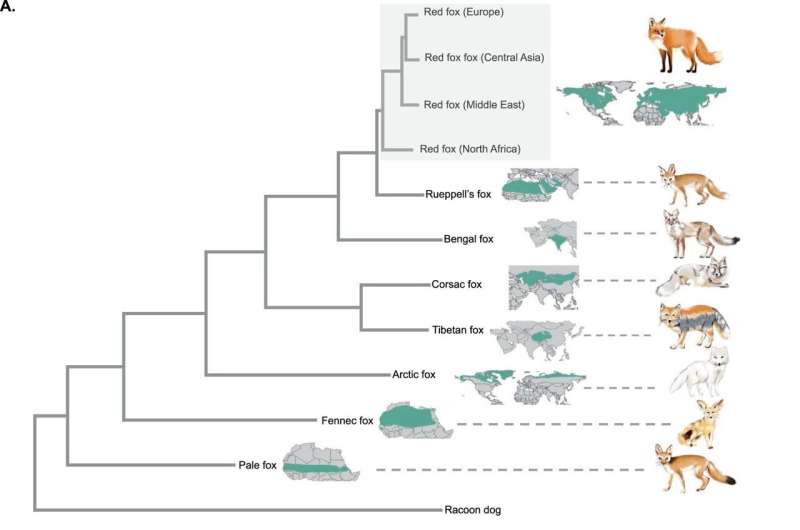June 14, 2023 report
This article has been reviewed according to Science X's editorial process and policies. Editors have highlighted the following attributes while ensuring the content's credibility:
fact-checked
peer-reviewed publication
trusted source
proofread
Genetic variation, selection and hybridization all contribute to desert adaptation in foxes

Genomic research led by the University of California at Berkeley has looked to uncover the origins and history of desert adaptation in foxes. In a paper, "North African fox genomes show signatures of repeated introgression and adaptation to life in deserts," published in Nature Ecology and Evolution, the researchers reveal what the fox genes say about their evolutionary path.
In extreme desert specialists Rueppell's fox (V. rueppellii) and fennec (V. zerda), the study identified repeated signatures of genes affecting kidney water homeostasis, supportive gene expression and physiological differences. In North Africa, both of these foxes can survive in the largest extreme heat and water-scarce environment on Earth, the Sahara desert.
Both foxes also have reduced mass-adjusted basal metabolic rate and non-renal water loss compared to canid species living in habitats with water availability.
The sister species to the Rueppell's fox is the red fox (V. vulpes), a more widely distributed and ecologically adaptable species found in various habitats across the Northern Hemisphere. While Rueppell's and red foxes probably share a Eurasian origin, they differ fundamentally in ecology, morphology, behavior and physiology due to divergent evolution and adaptations to different ecological niches.
The two sister species overlap in range at the outer edges of southern Asian deserts and the northern fringes of the Sahara, offering researchers a natural laboratory for addressing questions about adaptation, evolution and natural selection processes.
The research team sequenced the complete genomes of 30 North African red foxes, sampled along a climatic gradient ranging from dry subhumid to hyperarid regions, to represent potential diversity across its geographic range.
Sequencing was also performed on 18 Eurasian red foxes, 24 North African Rueppell's foxes, and ten genomes belonging to two divergent North African species: desert specialist fennec fox (n = 5) and the pale fox (n = 5; V. pallida).
The collected genomes were analyzed along with data from other canid species using a suite of statistical methods that consider genotype uncertainty by working directly on genotype likelihoods. The arctic fox and domestic dogs' genome assemblies were used as references in parallel analyses with interesting but unrelated connections found of an unknown contributor to both arctic foxes and the Eurasian red fox.
The results show that Rueppell's fox differentiated from the red fox around 576,000 years ago and evolved to inhabit extreme hot deserts, including the Sahara, but might not have done so entirely on its own. Rueppell's fox carries a large block of genes it picked up from an extinct ancient fox through hybridization, one related to the fennec, suggesting that both may have inherited some of their desert survival skills from this predecessor.
Red foxes radiated from Eurasia and later dispersed into North Africa around 78,000 years ago. As a somewhat recent desert edge inhabitant, the red fox is already showing off some adaptations to desert living but also has not done so entirely on its own. Evidence of hybridization events with Rueppell's fox suggests selection is getting a boost from previous genetic adaptations.
The research shows that genetic variation, selection, and hybridization events contribute to fox evolution and adaptation in extreme desert environments.
More information: Joana L. Rocha et al, North African fox genomes show signatures of repeated introgression and adaptation to life in deserts, Nature Ecology & Evolution (2023). DOI: 10.1038/s41559-023-02094-w
Journal information: Nature Ecology & Evolution
© 2023 Science X Network


















